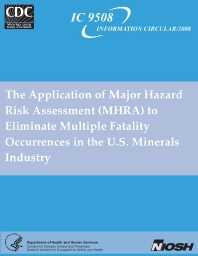Mining Publication: The Application of Major Hazard Risk Assessment (MHRA) to Eliminate Multiple Fatality Occurrences in the U.S. Minerals Industry
Original creation date: October 2008
Major Hazard Risk Assessment (MHRA) is used to help prevent major hazards, e.g., fire, explosion, wind-blast, outbursts, spontaneous combustion, roof instability and chemical and hazardous substances, etc., from injuring miners. The structured process associated with MHRA helps to characterize the major hazards and evaluate engineering, management and work process factors that impact how a mine mitigates its highest risk. The National Institute for Occupational Safety and Health (NIOSH) studied the application of this technique to US mining conditions through a field-oriented pilot project. Risk assessment teams used in the pilot project were primarily composed of mining company personnel. Ten case studies were performed over a wide cross-section of mines. These mines were representative of the important mining commodities in the US minerals industry, i.e. coal, metal, non-metal, and aggregate. Also, the sizes of the mines ranged from small to large and were located across the country. The ten case studies demonstrate that most US mines have the capability to successfully implement an MHRA and that the MHRA methodology produced additional prevention controls and recovery measures to lessen the risk associated with a select population of major mining hazards. The basic ingredient for a successful MHRA is the desire to become more proactive in dealing with the risks associated with events that can cause multiple fatalities. A successful outcome is marked by a thorough examination of existing prevention controls and recovery measures. When pressed to consider more controls to further mitigate the risk, a well-staffed risk assessment team was able to identify additional controls. For these mining operations, it was important to add additional controls, even if they were not required by existing mining regulations, to lower the risks associated with the major hazards under consideration. If a mining operation is not willing to commit its best people to an MHRA or will not provide them with sufficient time to see the process through to its conclusion, the MHRA output may prove to be useless. Additionally, if a mining operation is not prepared to discuss its major hazards in an open and honest fashion and to present the findings of the risk assessment in a written report, the MHRA output will be unclear, and attempts to monitor or audit important controls may not be possible. A MHRA is most effective when the mining operation possesses 1) a proper understanding of its hazards, 2) experience with informal and basic-formal risk assessment techniques, 3) proper facilities, machinery and equipment, 4) suitable systems and procedures that represent industry Best Practice, 5) appropriate organizational support with adequate staff, communications and training, 6) a formal and thorough plan for emergency response, and 7) a safety risk management approach that is promoted and supported at all levels of the organization.
Authors: AT Iannacchione, FD Varley, TM Brady
Information Circular - October 2008
NIOSHTIC2 Number: 20034694
Pittsburgh, PA: U.S. Department of Health and Human Services, Public Health Service, Centers for Disease Control and Prevention, National Institute for Occupational Safety and Health, DHHS (NIOSH) Publication No. 2009-104, Information Circular 9508, 2008 Oct; :1-132
See Also
- Analyzing Factors Influencing Struck-By Accidents of a Moving Mining Machine by Using Motion Capture and DHM Simulations
- A General Framework for Prioritizing Research To Reduce Injuries and Diseases in Mining
- Methods for Determining Roof Fall Risk in Underground Mines
- Peak Methane Concentrations During Coal Mining: An Analysis
- Practical Risk Assessment Guidelines for Identifying, Assessing, and Mitigating Stored Energy Hazards in Underground Coal Mines During and After a Mine Emergency
- Preventing Equipment Related Injuries in Underground U.S. Coal Mines
- Safety Framework for Programmable Electronics in Mining
- SPONCOM - A Computer Program for the Prediction of the Spontaneous Combustion Potential of an Underground Coal Mine
- SponCom - Spontaneous Combustion Assessment Software - 2.0
- Technology News 545 - NIOSH Updates Spontaneous Combustion Assessment Software
- Content source: National Institute for Occupational Safety and Health, Mining Program


 ShareCompartir
ShareCompartir
